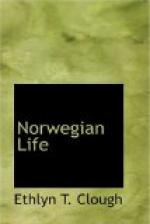society, its accepted laws and precepts, and vented
his moral skepticism in bitter sarcasm and cutting
paradoxes. “But two things are white in
this world,” he would say, “innocence and
arsenic.” The coupling of the two, however,
nearly proved fatal to him. He was involved in
a mysterious affair of poisoning, in which the victim
was a dunning creditor. He was suspected of having
given him arsenic by way of ridding himself of the
debt which he could not pay. No proof of the
fact could be adduced, and the crime was never brought
home to him; but public opinion was against him, and
fearing or distrusting the justice of his country,
he fled from it ere the case was tried. He wandered
over Europe and America, trying his hand at everything,
and died, a literary wreck, in Germany, longing, and
yet not daring, to return to his country. Lately,
the Society of Authors in Stockholm, judging that
his crime was “not proven,” while his literary
merits were great beyond all doubt, undertook the
rehabilitation of his memory. His remains were
brought back from Lubeck, and buried in Stockholm
with “literary” honors, among others a
remarkable oration delivered at his grave by Verner
von Heidenstam, in which he was styled a martyr in
the great cause of the emancipation of thought.
Whatever may be thought of his moral character, Almquist
was a great thinker and a wonderfully versatile writer.
The last of the romantics, he has been called a realist,
a psychologist, and a symbolist, and he was certainly
something of all these, half a century before the terms
became battle-cries in literature, and came to designate
literary schools. One critic has made him out
to have been a sort of forerunner of Ibsen, while
another calls him the most modern of classics.
His genius placed him in advance of his age in most
things. He was the first in the list of those
Scandinavian revolutionists who have laid out new
landmarks in the field of thought, and introduced new
methods in fiction and the drama.
Liberalism, which spread like wildfire over Europe
after its outbreak in the July Revolution in France,
reached Sweden soon after. It was represented
in literature by such men as Sturzen-Becker, Wetterbergh,
and Strandberg, writing under the names of Orvar Odd,
Uncle Adam, and Talis-Qualis; Blanche, who wrote stirring
novels in the style of Eugene Sue; Hjerta, and the
staff of the then newly founded Aftonbladet,
who were revolutionizing the press. The press
was beginning to enlist the highest literary capacities
of the country, gradually becoming what it now is,
a purveyor not only of news but of thought, and a
leader of opinion in literature and art, in science
and philosophy. In poetry, liberalism found its
echo in the verses of Malmstroem, Nybom, Schlstedt.
In fiction its banner was carried by three women,
two of whom—well known in England and America—Frederica
Bremer, whose novels portrayed the home life of the
middle class, Emelie Carlen, who idealized the fishermen
and sea-faring folk of the West Coast, and Sophie
von Knorring, who gave rather stilted descriptions
of life in aristocratic circles. All three were
very productive, and their novels count by dozens.
Yet they failed to sustain the reputations their first
works had won for them.




